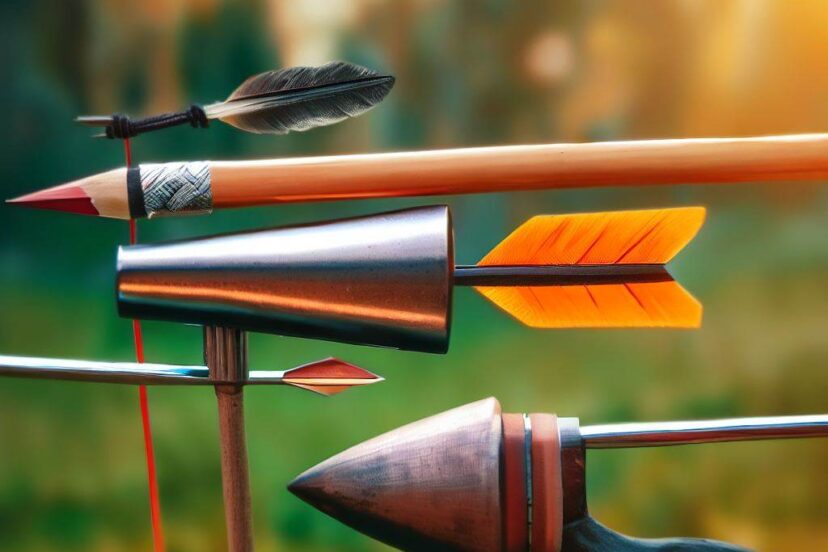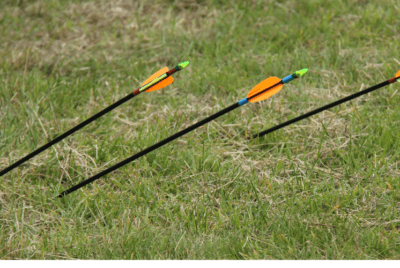Unveiling the Essential Parts of an Arrow – A Complete Guide
Archery is a fascinating sport that requires precision, skill, and the right equipment. Understanding the different components that make up an arrow is crucial for any archer, whether you’re a beginner or an experienced shooter. In this article, I’ll take you through the various parts of an arrow, explain their importance, and provide helpful suggestions for selecting the right components.
Introduction
Before we delve into the specifics, let’s start with a brief overview of the basic components of an arrow. An arrow consists of four primary parts: the shaft, fletching, nock, and point. Each of these elements plays a vital role in the arrow’s flight, accuracy, and performance.
Basic Components of an Arrow
Shaft
The shaft is the main body of the arrow and is responsible for its strength and durability. It comes in various materials, including wood, aluminum, and carbon. Wood shafts are traditional and offer a classic appeal, but they require more maintenance. Aluminum shafts are lightweight and widely used, while carbon shafts are known for their exceptional strength and consistency.
Fletching
Fletching refers to the feathers or plastic vanes attached to the rear end of the arrow. These vanes stabilize the arrow during flight, providing stability and accuracy. Feathers have been used for centuries and offer excellent flight control, especially in outdoor conditions. Plastic vanes, on the other hand, are more durable and perform better in wet or humid environments.
Nock
The nock is a small plastic piece located at the rear of the arrow, which connects the arrow to the bowstring. It ensures consistent arrow placement on the bowstring and facilitates a clean release. There are different types of nocks available, including push-in nocks, pin nocks, and indexing nocks. Each type has its advantages, so choosing the right one depends on personal preference and the type of bow you use.
Point
The point, also known as the arrowhead, is the front tip of the arrow. It determines the arrow’s intended use and purpose. For target practice and general shooting, field points are commonly used. They have a sharp tip but are not designed for hunting. If you’re into bowhunting, you’ll need broadheads, which have razor-sharp blades for effective game penetration.
Different Types of Arrow Shafts
The arrow shaft is a critical component that affects the arrow’s performance and trajectory. Let’s explore the three main types of arrow shafts available in the market:
Wood
Wooden arrow shafts have a long history in archery and offer a traditional feel. They are often crafted from materials like cedar or birch. Wood shafts are known for their aesthetics and smooth shooting experience. They have a certain level of flexibility, which can help absorb shock and improve accuracy. However, wood shafts require regular maintenance, including sanding, sealing, and checking for cracks or splits. They may not be as durable as other modern shaft materials.
Aluminum
Aluminum arrow shafts gained popularity with the advent of modern archery equipment. They are lightweight, durable, and provide consistent performance. Aluminum shafts offer excellent straightness and are less affected by external factors like temperature and humidity. They are available in various diameters and wall thicknesses, allowing archers to choose the optimal shaft for their needs.
Carbon
Carbon arrow shafts have revolutionized the archery industry with their exceptional strength-to-weight ratio. They are incredibly lightweight, durable, and offer excellent consistency in performance. Carbon shafts are known for their high-speed capabilities and ability to retain energy during flight. They are less affected by wind drift and provide tight groupings. However, carbon shafts can be more expensive than wood or aluminum options.
Choosing the right arrow shaft depends on your shooting style, preferences, and budget. If you value tradition and aesthetics, wood shafts may be a good choice. For consistent performance and versatility, aluminum shafts are a popular option. If you seek maximum performance and are willing to invest more, carbon shafts are the way to go.
Fletching Options
Fletching plays a crucial role in stabilizing the arrow during flight, ensuring accuracy and consistency. Let’s explore the two main types of fletching options:
Feathers
Feathers have been the traditional choice for fletching arrows. They offer excellent flight control, stability, and forgiveness. Feathers have natural barbs that create drag, helping to steer the arrow in the desired direction. They perform exceptionally well in outdoor conditions, where wind can affect arrow flight. Feathers require occasional maintenance, such as fluffing and replacement if damaged.
Plastic Vanes
Plastic vanes have gained popularity due to their durability and versatility. They are typically made of materials like plastic or rubber and come in various shapes and sizes. Plastic vanes offer consistent performance and are less affected by weather conditions. They are particularly useful in wet or humid environments where feathers may lose their effectiveness. Plastic vanes are low maintenance and can withstand rough handling.
Choosing between feathers and plastic vanes depends on personal preference and shooting requirements. Feathers provide a traditional feel and excel in outdoor conditions, while plastic vanes offer durability and versatility.
Nock Types
The nock is a small but essential part of the arrow that ensures consistent arrow placement on the bowstring and a clean release. Let’s discuss the three common types of nocks:
Push-in Nocks
Push-in nocks are the most common type and are compatible with various arrow shafts. They have a snug fit and are easy to install or replace. Push-in nocks come in different sizes to accommodate different arrow diameters. They offer simplicity and convenience, making them a popular choice for many archers.
Pin Nocks
Pin nocks have a pin-like structure that securely holds the arrow on the bowstring. They provide a positive connection, minimizing the chance of accidental arrow release. Pin nocks are often used in competitive archery, where consistency and precision are crucial. They require precise alignment with the arrow shaft and may need specialized tools for installation.
Indexing Nocks
Indexing nocks have a unique feature that allows you to align the fletching correctly on the arrow shaft. They have an index or indicator that helps ensure consistent positioning of the fletching, resulting in improved arrow flight and accuracy. Indexing nocks are especially useful for archers who value consistency and fine-tuning their equipment.
Choosing the right type of nock depends on your shooting style, equipment compatibility, and personal preference. Push-in nocks are versatile and user-friendly, while pin nocks offer a secure connection for precise shooting. If you’re seeking enhanced fletching alignment, indexing nocks can be a valuable addition to your setup.
Arrow Points
The arrow point, also known as the arrowhead, determines the arrow’s purpose and intended use. Let’s explore the two main types of arrow points:
Field Points
Field points are the most common type of arrow points used for target practice and general shooting. They have a sharp tip but are not designed for hunting. Field points are typically made of steel or other durable materials and come in various weights. They provide excellent accuracy and consistency, making them ideal for honing your archery skills.
Broadheads
Broadheads are specifically designed for hunting and offer maximum penetration on game animals. They have razor-sharp blades that cause significant damage upon impact, ensuring ethical and effective kills. Broadheads come in different styles, including fixed-blade and mechanical (expandable) options. It’s essential to choose the appropriate broadhead weight and design based on your hunting needs and local regulations.
When selecting arrow points, consider your shooting goals. If you’re primarily focused on target practice, field points are the way to go. For hunters, choosing the right broadhead is crucial to ensure clean and humane kills.
Choosing the Right Arrow for Your Needs
Selecting the right arrow involves considering various factors to optimize your shooting experience. Here are some key aspects to keep in mind:
Purpose of Use
Define your primary purpose for using the arrows. Are you planning to engage in target shooting, competitive archery, or hunting? Each activity may require specific arrow characteristics.
Draw Weight
Consider the draw weight of your bow. Different bow types have varying draw weights, and using arrows that match your bow’s specifications is essential for safety and optimal performance.
Arrow Length
The length of the arrow should be appropriate for your draw length. It’s crucial to consult with a knowledgeable archery professional to determine the correct arrow length for your specific setup.
Bow Type
Consider the type of bow you use. Whether it’s a recurve bow, compound bow, or traditional longbow, certain arrows may be better suited for each type.
By taking these factors into account, you can narrow down your options and choose arrows that complement your shooting style and maximize your performance.
Maintaining and Caring for Arrows
To ensure the longevity and optimal performance of your arrows, proper maintenance is essential. Here are a few tips for caring for your arrows:
- Inspect regularly: Regularly check your arrows for any signs of damage, such as cracks, splinters, or bent shafts. Damaged arrows should be replaced to avoid any potential safety hazards.
- Clean after use: Clean your arrows after each use to remove any dirt, debris, or moisture. Use a soft cloth or brush to wipe down the shafts and fletching. Avoid using harsh chemicals that may damage the arrow components.
- Store properly: Store your arrows in a cool, dry place away from direct sunlight. Use arrow tubes or quivers to protect them from impacts and ensure they remain straight and undamaged.
- Re-fletch if needed: If the fletching becomes worn or damaged, consider re-fletching the arrows. This process involves replacing the feathers or vanes to maintain optimal flight characteristics.
By following these maintenance practices, you can extend the lifespan of your arrows and maintain their performance over time.
Conclusion
I hope this article has provided you with valuable insights into the various parts of an arrow and how they contribute to your overall shooting experience. By understanding the characteristics of arrow shafts, fletching options, nock types, arrow points, and considering factors like purpose of use, draw weight, arrow length, and bow type, you can make informed decisions when selecting arrows that align with your specific needs and preferences.
Remember, choosing the right arrows is crucial for accuracy, consistency, and safety. It’s essential to invest in high-quality arrows that match your equipment and shooting style. Regular maintenance and care will ensure the longevity and optimal performance of your arrows, allowing you to enjoy the sport of archery to its fullest.
If you have any further questions or need additional guidance, don’t hesitate to reach out to fellow archers, local archery clubs, or professionals who can provide personalized advice and support. Happy shooting and may your arrows always find their mark!
FAQs
1. Can I use wood arrows for hunting?
While wood arrows have a traditional appeal, they may not be the best choice for hunting. Wood shafts can be less durable and more prone to breakage compared to modern materials like carbon or aluminum. For hunting, it’s recommended to use arrows specifically designed for that purpose, such as those equipped with broadheads.
2. What is the benefit of using feathers for fletching?
Feathers offer excellent flight control and stability due to their natural barbs, which create drag and help steer the arrow. They perform well in outdoor conditions where wind can influence arrow flight. Feathers also provide a traditional and aesthetically pleasing look to the arrows.
3. Can I interchange different types of nocks on my arrows?
It depends on the compatibility between the arrow shaft and the specific type of nock. Different arrow shafts may have varying internal diameters, requiring specific nock sizes. It’s important to choose nocks that are compatible with your arrow shafts to ensure a proper fit and reliable performance.
4. How often should I replace my arrow points?
Arrow points, especially field points, generally have a long lifespan if they are not damaged or bent. However, it’s essential to inspect them regularly for any signs of wear or damage. If you notice any issues, such as dull or bent tips, it’s advisable to replace them to maintain optimal accuracy and penetration.
5. Can I mix and match different components from various arrow brands?
While it is possible to mix and match arrow components from different brands, it’s important to consider compatibility and performance. Each brand may have specific design characteristics that can affect arrow flight and accuracy. It’s recommended to consult with experienced archers or professionals to ensure compatibility and optimize your arrow setup.






Comments are closed.